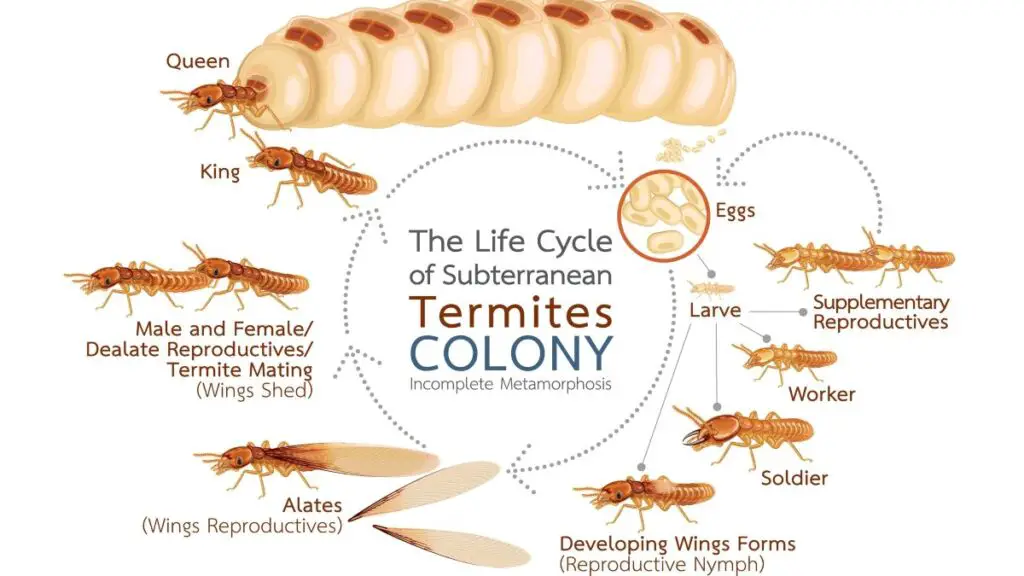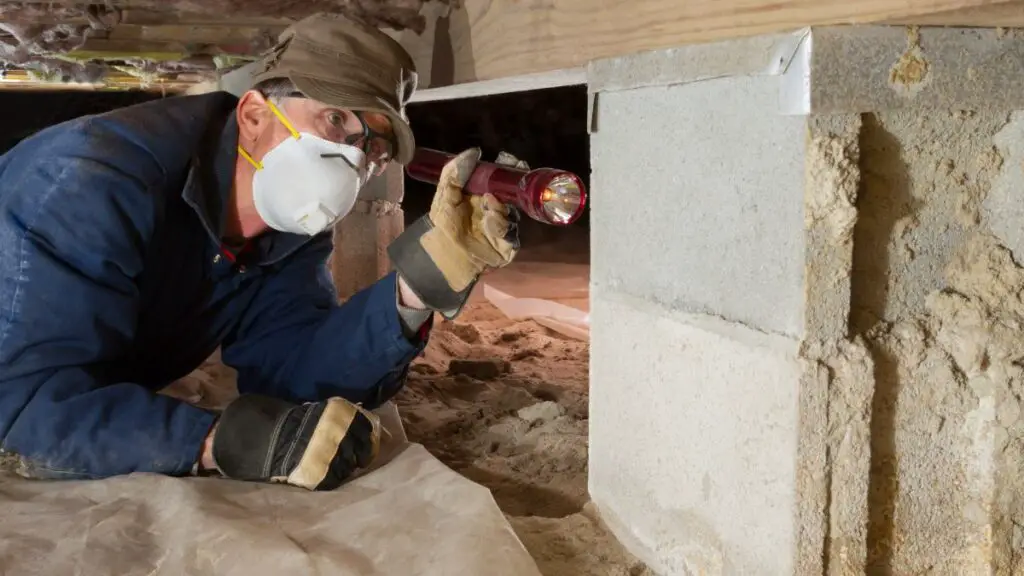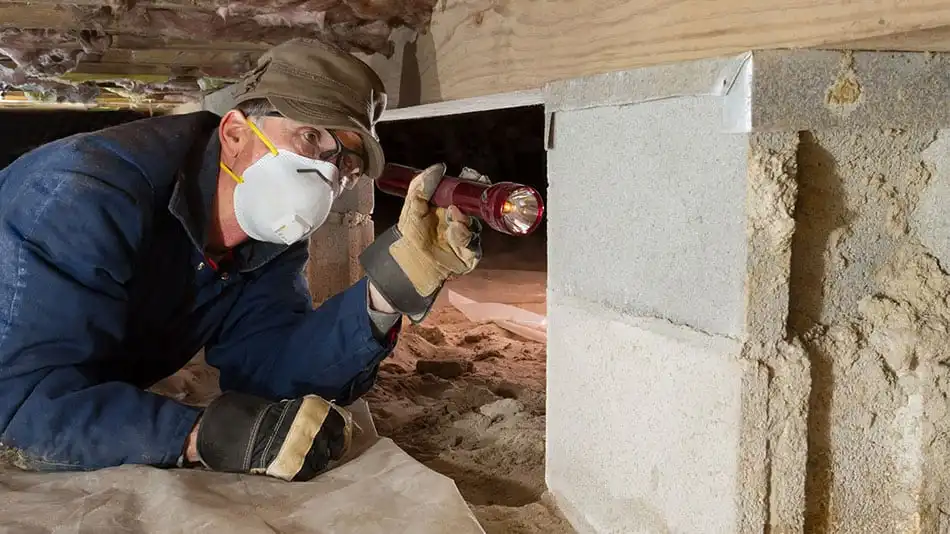Termites are notorious for the extensive damage they can inflict on your property. They feed on cellulose, a component found in wood, making our homes a prime target.
Understanding their impact is crucial, but knowing how to tell old termite damage from new termite damage helps identify the current level of termite infestation, determine the urgency of remedial actions, and implement effective strategies to control and eradicate termites.
Indicators of old termite damage are darkened or blistered wood, smooth galleries, no mud, and termite droppings. Conversely, new termite damage signifies an ongoing infestation, necessitating urgent attention and treatment from a termite specialist. Signs of new damage are live termites, mud/soil in galleries, fresh frass, and discarded termite wings.
Identifying the old from the new termite damage help assess the effectiveness of previous termite treatment measures, help make informed decisions, and help allocate resources more efficiently. We have uncovered the secrets of identifying old versus new termite damage below to guide you.
| Key Takeaways |
|---|
| Termites have a complex life cycle that starts with a swarm and involves the development of nymphs into worker termites, soldiers, or new alates. |
| There are three main types of termites: subterranean, drywood, and damp wood, each with unique characteristics and behaviors. |
| Common signs of termite damage include mud tubes, frass, wood damage or hollow wood, and the presence of swarmers or discarded wings. |
| Old termite damage often has darkened or blistered wood, smooth galleries, and an absence of mud or soil. |
| New termite damage has live termites, mud or soil in the galleries, fresh frass, and recent swarmers or discarded wings. |
| Common treatments for termite infestations include liquid pesticides, bait systems, fumigation, and heat treatment. |
| Preventive measures against termite infestations include reducing moisture, keeping wood away from your home, sealing entry points, and regular inspections. |
Get FREE quotes from licensed pest control technicians in your area today. Whether you need spraying for ants, roaches, spiders, ticks, mosquitos, or bed bugs, We Can Help! All technicians are screened, licensed, and insured.
Understanding Termites: Life Cycle, Types, and Behaviors
The termite life cycle starts with winged termites, known as alates, that leave their colony to mate and start new colonies. After mating, they shed their wings and become the king and queen of their new colony.
The queen lays eggs, which hatch into nymphs. These nymphs then develop into worker termites, soldier termites, or new alates, depending on the needs of the colony. This cycle continues, contributing to the active termite colony’s growth and survival.
Primarily, you’ll encounter three types:

Subterranean Termites
Subterranean termites are species of termites that are highly destructive to homes due to their nesting habits, massive subterranean termite colonies, wood digestion capabilities, hidden activity, and moisture dependency. They build their nests in the ground and construct tunnels (mud tubes) to access above-ground wood, a great food source.
With colonies numbering in the hundreds of thousands or even millions, they can cause extensive damage quickly. Subterranean termites feed on wood from the inside out, making detection challenging until significant damage has occurred.
Fun Fact
Subterranean is a type of termite that are able to digest cellulose, aided by specialized microorganisms, which allows them to consume and digest wood effectively. This study is able to isolate 5 bacteria from the gut of subterranean termite Psammotermes hypostoma Desneux that played a role in cellulose digestion in the gut.
Drywood Termites
Drywood termites live in the wood they consume and are often found in attic spaces. They require no contact with the soil but leave behind distinctive piles of frass or termite feces/droppings.
Dampwood Termites
Dampwood termites prefer damp, rotting wood. They’re less likely to infest homes but can be problematic in damp, wooded areas.
Related reading: What Do Termites Eat?
What Does An Active Termite Infestation Look Like
As you navigate the world of termite damage, knowing what to look for is half the battle. So, let’s explore the common signs of active termite damage and how to distinguish them from other types of damage.
Common Signs of Termite Damage
Termites are sneaky, wood-destroying insects. They can cause extensive damage before you even realize they’re there. But fear not; there are telltale signs you can look for:
- Mud Tubes: Subterranean termites, is a common termite that builds pencil-sized shelter tubes as pathways from their colony in the soil to the wood in your home. You will find these on your foundation or any other part of your home that touches the ground.
- Frass: Drywood termite colonies leave behind wood-colored piles of droppings known as frass. Finding a pile indicates a nearby colony.
- Hollowed or Damaged Wood: Termites eat wood from the inside out, leaving behind a thin veneer of wood or paint. After tapping on an area damaged by termites, a hollow-sounding wood is another sign of infestation, as some of the wood is eaten away.
- Swarmers or Discarded Wings: Swarmers, or reproductive termites, fly from their colony to mate and start a new colony. A pile of discarded wings is a sign of an active infestation.
Termite Damage vs. Other Damage
Termite damage can often be mistaken for water damage or wood rot. Here’s how to tell the difference:
- Water Damage: Wood damaged by water often swells and warps. While termites can cause wood to blister or appear wavy, it’s usually accompanied by mud tunnels or frass.
- Wood Rot: Rotten wood is typically discolored and easily crumbles. However, termite-damaged wood has a honeycomb interior and appears intact from the outside.
Tip
Look for the signs mentioned above and use a
flashlight for better visibility. Remember, termites prefer dark, humid areas. So, check your basement, crawl spaces, and any wood that’s near the ground.

How to Tell Old Termite Damage from New: Spotting the Differences
Now that you’re familiar with the signs of termite damage let’s delve into the crux of the matter: how to tell old termite damage from new. This distinction is crucial as it helps you understand whether the infestation is active or a relic of the past.
Characteristics of Old Termite Damage
Old termite damage has its own set of characteristics. Here’s what you need to look for:
- Darkened or Blistered Wood: Termite-damaged wood structures can darken or blister over time. This is due to the prolonged exposure to moisture and fecal materials within the termite galleries.
- Smooth Galleries: The tunnels or galleries that termites carve into pieces of wood become smooth and polished over time. This results from the termites’ constant movement and the hardening of the fecal matter used to construct the tunnels.
- Absence of Mud or Soil: In old termite damage, you may not find any mud or soil within the galleries. The termites have likely moved on, and the mud or soil has dried up and fallen out.
- Presence of Frass: Drywood termites push their fecal pellets or frass out of their galleries. If you find frass but no other signs of active termites, this could indicate old damage.
Characteristics of New Termite Damage
New termite damage, on the other hand, has a different set of indicators:
- Presence of Live Termites: The most obvious sign of new damage is the presence of live termites. If you break open a piece of termite-damaged wood and find active termites, you know the damage is new.
- Mud or Soil in Galleries: Subterranean termite infestation uses mud or soil to construct their galleries. If you find moist mud or soil in the galleries, this is a sign of new damage.
- Fresh Frass: If you find fresh frass near the damaged wood, this could indicate new damage. Remember, drywood termites regularly clean out their galleries by pushing out the frass.
- Recent Swarmers or Discarded Wings: If you’ve recently seen swarmers or found discarded wings, this could indicate new termite damage. Swarmers are reproductive termites that leave their colony to start a new one.
Remember
Whether the damage is old or new, it’s crucial to address the issue.
Old inactive termite damage indicates that your home is attractive to termites, and new damage means you have an active infestation. In both cases, you need to take steps to protect your home from further damage.
Inspection and Detection: Your First Line of Defense Against Termites
Uncovering termite damage is a bit like detective work. You need to know what to look for, where, and how to interpret what you find.
Let’s explore the steps involved in inspecting for termite damage, the tools and techniques used, and why termite professional inspections are crucial.

6 Steps to Inspect for Termite Damage
Conducting a termite inspection involves a systematic approach. Here’s a step-by-step guide:
- Prepare for the Inspection: Gather a
flashlight , screwdriver, pocketknife, and probing tool. Wear protective clothing, especially if you’ll be crawling under your house or going into your attic. - Inspect the Exterior: Start with the exterior of your home. Direct your attention to mud tubes on the foundation, woodpiles, and any wooden structures that touch the ground. Check window sills and frames for signs of major damage.
- Check the Interior: Check baseboards, window and door frames, and hardwood flooring. Pay special attention to areas where wood comes into contact with the ground.
- Probe Suspected Areas: Use your screwdriver or pocketknife to probe suspected areas. A soft wood is an evidence of termite damage.
- Look for Frass: Keep an eye out for frass, the wood-colored droppings left by drywood termites.
- Check Moist Areas: Termites are attracted to moisture, so check your basement, bathrooms, and under sinks.
Tools and Techniques Used in Termite Detection
While a
- Moisture Meters can detect high levels of moisture in walls.
- Infrared Cameras can detect heat patterns caused by current termite activity within foundation walls.
- Acoustic Emission Detectors can pick up the sound of termites feeding.
- Borescopes allow termite control experts to look inside walls or other inaccessible areas.
The Importance of Professional Inspections
While DIY inspections can help you spot obvious signs of termite damage, professional inspections are essential for several reasons:
- Expertise: Professionals have the training and experience to spot signs of undetected termite damage you might miss.
- Comprehensive Inspection: Professionals inspect all areas of your home, including hard-to-reach places like crawl spaces and attics.
- Accurate Assessment: Professionals can accurately determine the extent of the damage and whether it’s old or new.
- Treatment Recommendations: After the inspection, professionals can recommend the most effective treatment options.
A professional inspection is the most reliable way to detect termite activity, assess the extent of the damage, and get treatment recommendations. It’s a small investment that could save you time, money, and stress in the long run.
Related reading: Does a Home Inspector Check for Termites in a Home Inspection?
Treatment and Prevention: Winning the Battle Against Termites
Once you’ve detected termite activity, the next step is treatment. But the fight against termites doesn’t end there. Prevention is just as important to keep these destructive pests at bay.
Let’s explore common treatments for termite infestations, preventive measures, and the importance of regular inspections and early detection.
Common Treatments for Termite Infestations
When it comes to treating termite infestations, you have several options. Here’s a summary table of the pros and cons of each treatment:
| Treatment Method | Pros | Cons |
|---|---|---|
| Liquid Pesticides (Termiticides) | Effective at creating a barrier that kills termites on contact or when they return to the colony. | Require significant soil treatment and can be harmful to the environment. |
| Bait Systems | Gradually kills off the entire colony as termites share the bait. | Take time to be fully effective as it relies on termites finding and consuming the bait. |
| Fumigation | Highly effective for treating drywood termite infestations, killing all termites. | Requires leaving the home during treatment and can be costly. |
| Heat Treatment | Eco-friendly option that doesn’t use chemicals. | Highly effective for treating dry wood termite infestations, killing all termites. |
Preventive Measures Against Future Infestations
Prevention is key when it comes to termite control. Here are some steps you can take to protect your home from potential infestation:
- Reduce Moisture: Termites love moisture. Fix leaks, ensure proper drainage, and keep your gutters clean.
- Keep Wood Away from Your Home: Wood piles, mulch, and tree stumps near your home can attract termites. Keep these as far away from your home as possible.
- Seal Entry Points: Seal cracks and holes in your home’s foundation to prevent termites from getting in.
- Regularly Inspect and Maintain Your Home: Establishing an annual termite inspection schedule and conducting regular maintenance can help you proactively identify signs of termite activity early on. By doing annual inspections, you can promptly address the issue before it leads to substantial damage.
FAQs About How To Tell Old Termite Damage From New One
You’re bound to have questions in your quest to understand termite damage. Here, we’ll answer some of the most common questions about termite damage.
How to tell if termites are active in your house?
Look for signs like mud tunnels, drywood termite frass, hollowed or damaged wood, and swarmers or discarded wings. Use a screwdriver or pocket knife to probe suspected areas.
How do you determine the extent of termite damage?
A termite inspector determines the extent of termite damage using moisture meters to detect moist wood levels, infrared cameras to identify heat patterns caused by termite activity, acoustic emission detectors to pick up the sound of termites feeding, and borescopes to visually inspect inside walls or other inaccessible areas.
How do you know if termite damage is structural?
Identifying structural termite damage involves checking load-bearing areas of your home, such as beams, joists, and the foundation.
What should I do if I find termite damage?
Contact a professional pest control company immediately. They conduct a thorough inspection, confirm termites’ presence, assess the damage’s extent, and recommend the most effective treatment options.
How to tell how long termites have been there?
A pest control professional can provide a more accurate estimate based on the extent and severity of the damage.
I found termite damage but no termites. What does it mean?
Discovering termite damage without finding live termites suggests that the infestation may have subsided or that the termites are hiding.
Conclusion
Dealing with termites involves a three-pronged approach: treatment, prevention, and regular inspections. By understanding the options available and taking proactive steps, you can your peace of mind and protect your home from these destructive pests.
Early detection is key when dealing with termites. The sooner you identify an infestation, the sooner you can eliminate it and prevent further damage. Remember, an ounce of prevention is worth a pound of cure when it comes to termites.
So, stay vigilant, take action at the first sign of trouble, and don’t hesitate to call in the professionals when needed. Your home is worth it, and it will thank you for your diligence.








